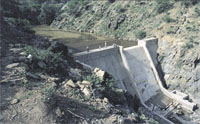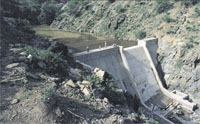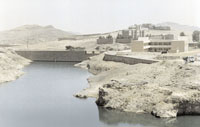
General Irrigation manager:”Government concerned about excessive water consumption for qat cultivation” [Archives:2008/1120/Health]
January 14 2008
 |
 |
In aggregate, the country has scarce water resources, which may pose an insurmountable obstacle to government efforts to improve the nation's agricultural production.
Ismail Al-Ghabri interviews Mutahar Zaid, general manager of the Ministry of Agriculture and Irrigation's General Irrigation Department.
Do the World Bank and other international organizations support water installations as part of Yemen's development plan?
The World Bank has supported many development plans, such as the Underground Water and Soil Reservation Project, implemented in two stages and now in its second stage, in addition to irrigation development and rain-fed agriculture projects, which are some of the projects directly relevant to the business of the General Irrigation Department.
Additionally, European donors have funded the construction of dams such as the Barquna and Waqir dams in the Tihama Plain, and similar installations now are being implemented with funds from the European Union, specifically Switzerland, which has been supporting Yemen's development projects since the 1970s.
Other installations and projects have been implemented through the French Coffee Project. The government has just received funds from various international donors to construct large dams, such as Abyan's Hassan Dam and Hodeidah's Serdoud Dam, both of which are to receive additional funds from the Abu Dhabi Fund.
Because there have been conflicts between the tasks of the Ministry of Agriculture and Irrigation, represented by the General Irrigation Department, and those of the Ministry of Water and Environment, what are the most critical conflicts still existing?
Republican decree No. 154 of 1995 established the General Corporation for Water Resources, with its sixth article stating that the corporation is the only government agency responsible for making policies and strategies to conserve water resources. The corporation now is affiliated with the Ministry of Water and Environment, which was established under a 2002 republican decree.
Republican decree No. 5 of 1996 concerning reshuffling the Agriculture and Irrigation Ministry granted it the power to exercise technical supervision over the use of irrigation means nationwide. The General Irrigation Department was tasked with constructing water installations, managing the irrigation process and monitoring the ministry's work and activities in its governorate branches.
The department then worked according to the National Water Strategy, established under 1998's Cabinet Decision No. 203, putting more emphasis on the general principles of water resource use and ownership, improving such resources and enacting water-related legislation.
Through this strategy, the General Corporation for Water Resources designated plans and policies for every sector operating in that area, as well as presenting the Water Resources Law to higher authorities for discussion, while the Ministry of Agriculture and Irrigation finalized the Irrigation Law in the meantime.
After a while, both laws were merged into one called the “Water Law.” After numerous meetings and discussions by Parliament, the new law was put into effect, thereby specifying each agency's tasks and duties. Supposedly, there was to be no contradiction between any two agencies operating in the area of water.
The matter requires good coordination between the relevant agencies in conformity with the tasks and duties contained in the legal articles.
Are there any difficulties ahead for the General Irrigation Department?
Well, there's no business without difficulties. We face numerous difficulties, ranging from those related to financial provisions for the work to conflicts that may occur between citizens in project-targeted areas. Such conflicts leave a negative impact on the implementation of any water installation.
Having heard about a future plan for 2007-2010 as part of the government's reform efforts, does this plan include any water projects?
Regarding the future plan, the ministry's General Irrigation Department does business according to directives from high-ranking officials and political leadership. Represented by the Irrigation Network Management, the General Irrigation Department has updated an investment program implemented by the U.N.'s Food and Agriculture Organization at a total cost of $85.4 million and seeking to provide irrigation networks for more than 200,000 hectares between 2007 and 2010.
Additionally, approximately $444 million has been allocated for water harvesting systems and activities, including rehabilitating agricultural terrain, protecting the banks of valleys, establishing valley water installations and constructing water harvesting systems such as large tanks and dams, thereby maximizing the benefits of rainwater.
The Ministry of Agriculture and Irrigation has just completed reference requirements for modern irrigation project consultants due to be in charge of conducting relevant studies and layouts. One aim of the project is to help various agricultural areas nationwide gain wider access to modern irrigation systems and provide services for nearly 50,000 hectares of agricultural land. The Ministry of Planning and International Cooperation has allocated YR 50 million for implementing this project's feasibility study.
Regarding threats posed by desertification, does the General Irrigation Department coordinate efforts in agricultural areas and if not, what are possible solutions?
Desertification is a universal problem involving land erosion in dry areas and caused by numerous factors, including climate change and daily human activities. Desertification involves a wider geographical scope and negatively impacts the climate and environment.
Yemen embodies all of the general characteristics of desertification, including land erosion and soil destruction, coupled with the effects of heavy flooding caused by torrential rains in some parts of the country.
The Yemeni government has just established the National Strategy to Combat Desertification, targeting several areas. As General Irrigation Department staff, our main job is to fight the spread of such a detrimental phenomenon by conserving water usage, developing water resources and ditches and coordinating between the relevant agencies.
The Minister of Water and Environment Abdul-Rahman Al-Eryani has declared that agriculture consumes nearly 90 percent of Yemen's water resources, holding qat cultivation accountable for the largest portion of consumption. How do you assess this issue?
First, the Ministry of Agriculture and Irrigation's role is limited to increasing the public's awareness about rationing water consumption and other relevant issues. Secondly, everyone knows Yemen has been famous for agriculture since ancient times.
According to studies by the Arab Organization for Agricultural Development, the Arab region averages 83 percent water usage for agricultural purposes. But because Yemeni agriculture consumes 90 percent of its water resources, its percentage is similar to that of those Arab countries known for excessive water consumption. So, we needn't hold any agricultural agency accountable for any extravagant water consumption.
We must take into account that water is the most important element in agricultural production; therefore, the Ministry of Agriculture and Irrigation isn't the only agency responsible for water consumption for agricultural purposes because the situation and conditions are similar in Yemen and other Arab countries, as well as worldwide.
However, various techniques and methods for rationing water consumption lead to efficient use of rainwater and irrigation systems, which consequently helps improve the economic returns from agriculture.
We at Modern Irrigation Systems Management currently are exerting much effort to increase farmers' awareness regarding using irrigation means for agricultural purposes and their feasibility for increasing both product quantity and quality.
Regarding qat cultivation and the significant consumption of water to grow it, this is a reality we can't deny; however, I don't think solving the problem by having farmers grow other crops in lieu of qat is the responsibility of only the Ministry of Agriculture and Irrigation. Because the issue is social in nature, it'll require much time to persuade Yemeni farmers to give up qat cultivation and consumption.
Formerly known as the Ministry of Agriculture and Water Resources, in the past, the ministry has decreed a package of water conservation measures, such as 1992's ministerial decree No. 46, which organized the digging of artesian wells (made by boring into the earth until reaching water, which flows spontaneously like a fountain from internal pressure; such wells usually are small in diameter and often of great depth) in an effort to conserve groundwater because qat farmers primarily rely on such wells in cultivating their crops.
The Ministry of Planning and International Cooperation and FAO conducted simultaneous studies on the situation and conditions of qat cultivation in Yemen, coming up with findings and recommendations similar to those reached by the National Anti-Qat Strategy.
Did the Yemeni government cut support for some projects related to building dams allegedly due to improper feasibility studies?
The government didn't cancel support for any project recommended via a proper feasibility study. However, concerning the Ministry of Water and Environment's viewpoint regarding special studies on Serdoud Dam, the ministry erred in its evaluation of the project by relying on the opinions of a Dutch delegation it had requested to assess the project, despite the fact that such delegation conducted no feasibility studies and visited the project only once.
The Ministry of Agriculture and Irrigation neither knew about the delegation's arrival, nor why it had come to Yemen. In fact, the group visited as part of joint efforts with a Pakistani firm contracted by the Yemeni government to implement the project's feasibility study.
The Ministry of Water and Environment received soft copies of the study, considered the first phase of the project's assessment, on CD, while the second phase included preparing technical reports, layouts and tender documentation.
How does the General Irrigation Department deal with conflicts between locals in project-targeted areas?
The department doesn't implement any projects in areas with tribal conflicts if it discovers that locals are disputing a project's chosen location unless the conflicting parties reach an agreement and make concessions regarding the lands/areas selected for dam construction. Additionally, the department waits until it receives signed and authenticated documents by concerned local authorities in the area or the province, indicating that the disputes are over.
Is it correct that there are conflicts between the Ministry of Planning and International Cooperation and the Ministry of Agriculture and Irrigation regarding the distribution of projects?
There are no conflicts between these ministries, which are jointly committed to integrated business in such a way that serves the public interest, in addition to being in harmony with the state's general policies and strategies and the government's plans and programs established according to development needs and criteria.
Which Yemeni areas suffer water shortage and thus require immediate action by the relevant authorities and can building dams solve the problem?
Many Yemenis know that numerous underground water basins are being threatened with depletion, mainly the Sana'a, Sa'ada and Taiz basins, despite the fact that the government has banned irresponsible consumption of groundwater and digging of artesian wells unless citizens obtain licensing by the relevant authorities to do so. As Yemeni citizens, our duty is to conserve groundwater in order to ensure a better future for our children.
Concerning the construction of dams and other water barriers, the Yemeni government now is giving top priority to harvesting and collecting rainwater during the rainy seasons through various means, including both large and small dams, which, in addition to providing large water reserves for watering agricultural crops during non-rainy seasons, also feed groundwater.
As a first step toward saving groundwater supplies from random depletion, the Yemeni Cabinet recently issued a decree, as well as directing relevant agencies within the agricultural sector to study the various means of water harvesting and collection in addition to the measures required to ration water consumption for agricultural purposes.
Are there any statistics on the exact number of dams in Yemen and their total cost and why did citizens get involved in constructing dams?
Until now, some 108 dams thus far have been constructed in various parts of the country, with an estimated storage capacity of 20,302,528 cubic meters of water. After Marib Dam, Qufl Al-Sayyad Dam in Dhamar's Ans district is Yemen's second largest, costing more than YR 200 million to build and holding up to 2 million cubic meters of water.
Regarding citizen involvement in dams construction, the government pays close attention to public efforts because they are vital to development processes. The public's engagement in such processes helps the government identify their development needs and thus intensifies efforts to meet them.
Are there any available statistics on water consumption used for qat cultivation?
Thus far, several studies have been done regarding qat cultivation and its direct effects on local community development. For example, the phenomenon was discussed at a 2002 national conference, which revealed that qat cultivation annually consumes up to 924 cubic meters of water per hectare in Sana'a governorate and 680 cubic meters in Ibb.
However, according to a 1992 study by the Higher Water Council, qat cultivation in Sana'a governorate requires an estimated 12,000 cubic meters annually. Additionally, results of various studies and surveys in numerous rural areas estimate that qat plants annually consume between 930 and 1,966 cubic meters of water per hectare in Hajjah, but nearly 1,640 cubic meters in Sana'a governorate.
How much water qat plants consume annually depends on climate changes from one area to another, but the average water consumption for qat cultivation in Yemen is believed to be 8,500 cubic meters per hectare annually.
Having just said qat consumes much water and that the government plans to encourage agricultural crops other than qat because they are believed to consume less water, how do you encourage Yemeni farmers to quit growing qat and grow other crops instead and who have any farmers done so?
This can be done by increasing farmers' awareness about the risks of growing qat, which isn't good for the country's development and is responsible for wasting the nation's water. However, such awareness may not successfully attain the desired goals due to the high economic returns farmers receive from growing qat.
The Yemeni government currently is expending many notable efforts to foster wheat production in various parts of the nation. Are there any studies on the effects of wheat growing on water reserves?
Government efforts to increase wheat production are being made in an attempt to meet Yemenis' growing demands for it. Like other agricultural crops, wheat doesn't require much water, so its consumption is limited. Most Yemeni agricultural areas where farmers grow wheat use rainwater rather than groundwater reserves via artesian wells. Additionally, the government plans to provide wheat farmers modern irrigation means in order to save water.
To what extent does building dams contribute to solving persistent agricultural problems and water shortage in Yemen?
The available dams and water barriers have contributed greatly to tackling the problem, as dams have proven to be an important and strategic solution to such problems in most world nations suffering water shortage, in addition to numerous other modern techniques for the same purpose.
However, the outcomes of such water installations remain symptomatic of the criteria and regulations governing water consumption by farmers for agricultural purposes.
——
[archive-e:1120-v:15-y:2008-d:2008-01-14-p:health]


